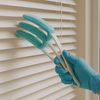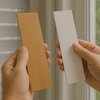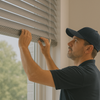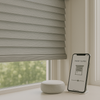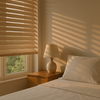Material Matters: Choosing the Right Blind Materials for Longevity and Safety
- by Mariam Labadze
Quick Answer
Choosing durable, safe blind materials requires matching composition to environmental conditions and household needs. PVC and aluminum excel in moisture-prone bathrooms and kitchens, lasting 10-12 years without warping or mold. Real wood suits dry living spaces but requires maintenance, whilst faux wood delivers authentic aesthetics with superior moisture resistance. Fabric quality varies tremendously—heavy-duty polyester resists fading and wear, whilst cheap synthetics deteriorate within 3-4 years. Safety considerations include flame-retardant treatments (avoid toxic chemicals, prefer natural wool barriers), VOC-free finishes preventing harmful off-gassing, and cordless mechanisms eliminating strangulation hazards. Quality materials cost 20-40% more initially but deliver 2-3 times longer lifespans, making them economically superior whilst providing safer, healthier home environments.
Understanding Material Properties
Durability Factors – Material longevity depends on inherent composition, environmental exposure, and maintenance requirements. Synthetic materials like PVC and aluminum resist moisture and UV damage exceptionally well, maintaining appearance and function for 10-15 years. Natural materials like wood and fabric offer aesthetic warmth but require appropriate conditions and care avoiding premature deterioration.
Thickness and density significantly affect durability across material types. Substantial 0.6mm+ PVC resists tearing and maintains rigidity better than thin 0.3mm alternatives. Heavy 300gsm+ fabrics withstand daily use whilst lightweight 150gsm materials show wear rapidly through pilling, thinning, or color fading.
Environmental Suitability – Matching materials to room conditions proves crucial for longevity. Moisture-resistant options (PVC, aluminum, faux wood) thrive in bathrooms and kitchens where humidity destroys fabric and warps real wood. Conversely, natural materials excel in dry bedrooms and living spaces where their aesthetic advantages shine without environmental challenges accelerating deterioration.
UV resistance matters for south and west-facing windows receiving intense sunlight. UV-stabilized materials maintain color and structural integrity whilst unprotected alternatives fade, become brittle, or degrade within 2-3 years despite otherwise suitable quality.
PVC: Practical and Proven
PVC (polyvinyl chloride) roller blinds represent ultimate practicality through complete moisture resistance, easy maintenance, and exceptional durability in challenging environments. The non-porous plastic surface repels water entirely, prevents mold growth, and wipes clean effortlessly—perfect for steamy bathrooms and cooking-splattered kitchens.
Quality PVC features UV stabilizers preventing yellowing and brittleness that plague untreated alternatives exposed to sunlight. This protection extends lifespan significantly, allowing PVC blinds maintaining fresh appearances for 10-12 years even in sunny positions where inferior materials would fail within half that time.
Thickness indicates quality directly—substantial 0.6-0.8mm PVC feels rigid and premium, whilst flimsy 0.3-0.4mm options appear cheap and develop creases or tears easily. Invest in heavier gauge materials for longevity, particularly in high-traffic areas or large windows where material stresses prove greater.
Safety Considerations – PVC production historically involved concerning chemicals, but modern manufacturing has improved significantly. Look for phthalate-free formulations and products meeting European safety standards ensuring materials don't off-gas harmful compounds affecting indoor air quality.
Fire resistance proves important for bedroom and escape route windows. Quality PVC often includes flame-retardant additives meeting UK safety standards without requiring separate chemical treatments that might contain problematic substances.
Aluminum: Industrial Strength
Aluminum venetian blinds offer unmatched durability through hard metal construction that absolutely won't warp, crack, or support mold growth regardless of environmental conditions. The material thrives where even PVC sometimes struggles—extremely humid bathrooms, direct constant sun exposure, or high-wear commercial applications.
Lightweight aluminum operates smoothly for years with mechanisms rarely requiring maintenance. The metal's inherent properties—corrosion resistance, dimensional stability, strength—create window treatments that genuinely function identically after a decade as when newly installed, assuming reasonable care.
Powder-coated finishes provide scratch resistance and extensive color options beyond natural metallic appearances. Quality coating application ensures finishes don't chip or peel during normal use, maintaining attractive appearances matching initial presentations throughout extended lifespans.
Safety Profile – Aluminum represents one of the safest blind materials—non-toxic, doesn't emit VOCs, and naturally fire-resistant without requiring chemical treatments. This clean safety profile suits health-conscious households, particularly those with children, elderly residents, or anyone with chemical sensitivities.
The primary safety concern involves sharp edges on damaged slats. Quality manufacturing with rolled edges and appropriate handling during cleaning prevents this issue, though replacing individual damaged slats proves straightforward and economical.
Real Wood: Natural Beauty with Care Requirements
Genuine wood blinds deliver unmatched aesthetic warmth and natural beauty that synthetic alternatives struggle replicating perfectly. Quality hardwoods—basswood, bamboo, or premium hardwoods—provide sufficient durability when appropriately maintained, lasting 15-20 years in suitable environments.
Moisture sensitivity represents wood's primary limitation. Bathroom humidity causes warping, whilst kitchen steam damages finishes. Reserve real wood for dry living spaces, bedrooms, and dining areas where environmental conditions don't challenge natural materials excessively.
Finish quality dramatically affects both appearance and longevity. Premium multi-coat finishes with UV protection resist fading and moisture penetration far better than basic single-coat treatments. This finishing quality proves difficult assessing online, making in-person viewing valuable before committing to wood blind investments.
Maintenance Requirements – Wood blinds benefit from periodic dusting, occasional conditioning with appropriate products, and protection from excessive moisture or direct sun exposure. This care commitment suits those genuinely appreciating natural materials and willing investing time maintaining them properly.
Safety Considerations – Natural wood without chemical treatments provides excellent safety from toxic exposure perspective. However, verify finishes use low-VOC or water-based formulations rather than solvent-based options that off-gas for extended periods after installation.
Fire resistance requires treatments that some households prefer avoiding due to chemical concerns. Balance these considerations based on risk assessment—upper floor bedrooms might prioritize avoiding chemical treatments, whilst ground floor escape routes might warrant fire-resistant options despite chemical presence.
Faux Wood: Best of Both Worlds
Faux wood blinds deliver authentic wood aesthetics without natural timber's moisture sensitivity, combining visual warmth with practical durability. Composite construction—typically PVC or polymer cores with wood-effect finishes—resists warping in bathrooms whilst maintaining convincing appearances indistinguishable from real wood at normal viewing distances.
Quality faux wood rivals or exceeds real timber's durability through engineered materials optimized for dimensional stability and moisture resistance. These blinds suit any room including humid bathrooms where genuine wood fails rapidly, providing design flexibility that material limitations don't constrain.
The substantial weight and appearance create premium impressions rivaling real wood whilst the practical benefits and moderate pricing (typically 30-40% less than equivalent genuine wood) deliver excellent value for style-conscious households wanting traditional aesthetics without maintenance commitments.
Safety Profile – Modern faux wood formulations have improved dramatically, with reputable manufacturers using phthalate-free PVC and low-VOC finishes. Verify safety certifications ensuring products meet current European standards for indoor air quality and material safety.
Fabric Quality Variations
Fabric blind quality spans enormous ranges from premium materials lasting 10+ years to cheap synthetics deteriorating within 3-4 years. Understanding quality indicators prevents expensive mistakes that initial low prices don't offset when premature replacement becomes necessary.
Weight and Density – Heavy 300gsm+ fabrics indicate substantial construction resisting wear, maintaining shape, and providing superior light control. Lightweight 150-200gsm materials feel flimsy, develop see-through worn patches, and fade rapidly under sunlight exposure.
Fiber Composition – Polyester provides excellent durability, color-fastness, and easy care making it ideal for blinds. Cotton offers natural appeal but fades and deteriorates faster without protective treatments. Blends balance aesthetics with practicality, though polyester-heavy compositions (80%+ polyester) deliver superior longevity.
UV Protection – Sun exposure destroys unprotected fabrics rapidly. UV-resistant treatments or inherently UV-stable fibers extend fabric life dramatically in sunny positions. This protection proves particularly important for south and west-facing windows receiving intense afternoon sun daily.
Moisture Considerations – Some fabrics tolerate humidity better than others. Synthetic polyesters resist moisture-related problems better than natural fibers prone to mold in damp environments. For bathrooms, specify moisture-resistant fabrics or choose non-fabric alternatives entirely.
Safety and Health – Fabric treatments for stain resistance, flame retardancy, or antimicrobial properties involve chemicals that may concern health-conscious households. Natural untreated fabrics avoid these exposures but sacrifice practical benefits that treatments provide. Balance these considerations based on personal priorities and risk assessments.
Cord Safety Evolution
Material safety extends beyond blind composition to operating mechanisms. Traditional corded blinds created strangulation hazards claiming young lives, driving regulatory changes mandating safer alternatives.
Cordless Systems – Spring-loaded or handle-operated cordless mechanisms eliminate hanging cords entirely, representing ultimate child safety. Modern cordless technology operates reliably across most blind types, making this the default recommendation for any household where children might visit, not just homes with resident youngsters.
Motorized Options – Completely eliminating manual controls removes all cord-related risks whilst adding convenience. This represents maximum safety combined with ultimate ease of use, though at premium pricing compared to manual cordless alternatives.
Wand Controls – Solid rigid wands replacing flexible cords on some vertical blinds provide compromise solutions—maintaining manual operation without creating loop hazards that flexible cords present. This approach suits those preferring manual control without cordless spring mechanisms.
Flame Retardancy: Balancing Safety and Health
UK building regulations require window treatments meeting fire safety standards, particularly in rental properties and multi-occupancy buildings. However, chemical flame retardants historically used raise health concerns, creating tension between fire safety and chemical exposure avoidance.
Natural Alternatives – Wool naturally resists flame without chemical treatments, making wool-blend fabrics excellent choices balancing fire safety with chemical avoidance preferences. Some modern synthetic fibers possess inherent flame resistance without requiring additional chemical treatments.
Chemical Treatments – Brominated and phosphate flame retardants prove effective but face health scrutiny. When chemical treatments prove necessary, seek products using newer, less problematic formulations meeting safety standards without legacy chemicals linked to health concerns.
Risk Assessment – Balance fire safety requirements against chemical exposure concerns based on specific situations. Escape route windows warrant prioritizing fire resistance, whilst upper-floor rooms away from likely fire sources might reasonably prioritize avoiding chemical treatments.
At 1 Click Blinds, we prioritize offering materials balancing longevity, safety, and environmental responsibility. Our range includes moisture-resistant PVC and aluminum for practical spaces, authentic wood and convincing faux alternatives for aesthetic appeal, and quality fabrics meeting appropriate safety standards—ensuring you find materials matching your priorities for durability, safety, and household wellbeing.

